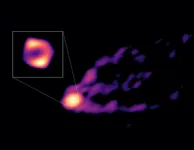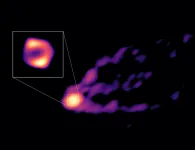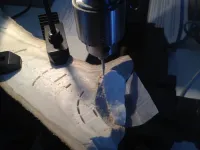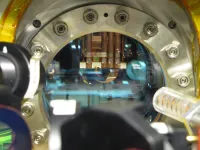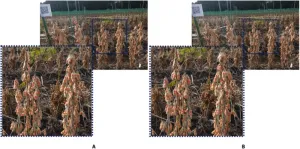(Press-News.org) The new chemical process is not limited to wind turbine blades but works on many different so-called fibre-reinforced epoxy composites, including some materials that are reinforced with especially costly carbon fibres.
Thus, the process can contribute to establishing a potential circular economy in the wind turbine, aerospace, automotive and space industries, where these reinforced composites, due to their light weight and long durability, are used for load-bearing structures.
Being designed to last, the durability of the blades poses an environmental challenge. Wind turbine blades mostly end up at waste landfills when they are decommissioned, because they are extremely difficult to break down.
If no solution is found, we will have accumulated 43 million tonnes of wind turbine blade waste globally by 2050.
The newly discovered process is a proof-of-concept of a recycling strategy that can be applied to the vast majority of both existing wind turbine blades and those presently in production, as well as other epoxy-based materials.
The results have just been published in the leading scientific journal Nature, and Aarhus University, together with the Danish Technological Institute, have filed a patent application for the process.
Specifically, the researchers have shown that by using a ruthenium-based catalyst and the solvents isopropanol and toluene, they can separate the epoxy matrix and release one of the epoxy polymer's original building blocks, bisphenol A (BPA), and fully intact glass fibres in a single process.
However, the method is not immediately scalable yet, as the catalytic system is not efficient enough for industrial implementation – and ruthenium is a rare and expensive metal. Therefore, the scientists from Aarhus University are continuing their work on improving this methodology.
"Nevertheless, we see it as a significant breakthrough for the development of durable technologies that can create a circular economy for epoxy-based materials. This is the first publication of a chemical process that can selectively disassemble an epoxy composite and isolate one of the most important building blocks of the epoxy polymer as well as the glass or carbon fibres without damaging the latter in the process," says Troels Skrydstrup, one of the lead authors of the study.
Troels Skrydstrup is a professor at the Department of Chemistry and the Interdisciplinary Nanoscience Center (iNANO) at Aarhus University.
The research is supported by the CETEC project (Circular Economy for Thermosets Epoxy Composites), which is a partnership between Vestas, Olin Corporation, the Danish Technological Institute and Aarhus University.
END
New chemistry can extract virgin-grade materials from wind turbine blades in one process
Danish researchers have developed a chemical process that can disassemble the epoxy composite of wind turbine blades – and simultaneously extract intact glass fibres as well as one of the epoxy resin's original building blocks in a high quality.
2023-04-26
ELSE PRESS RELEASES FROM THIS DATE:
Astronomers image for the first time a black hole’s shadow together with a powerful jet
2023-04-26
"Previously we had seen both the black hole and the jet in separate images, but now we have taken a panoramic picture of the black hole together with its jet at a new wavelength”, says Ru-Sen Lu, from the Shanghai Astronomical Observatory and leader of a Max Planck Research Group at the Chinese Academy of Sciences. The surrounding material is thought to fall into the black hole in a process known as accretion. But no one has ever imaged it directly. "The ring that we have seen before is becoming larger and thicker at 3.5 mm observing wavelength. This shows that the material falling into the black hole produces additional emission that is now observed in the new ...
New black hole images reveal a glowing, fluffy ring and a high-speed jet
2023-04-26
In 2017, astronomers captured the first image of a black hole by coordinating radio dishes around the world to act as a single, planet-sized telescope. The synchronized network, known collectively as the Event Horizon Telescope (EHT), focused in on M87*, the black hole at the center of the nearby Messier 87 galaxy. The telescope’s laser-focused resolution revealed a very thin glowing ring around a dark center, representing the first visual of a black hole’s shadow.
Astronomers have now refocused their view to capture a new layer of M87*. The team, including scientists at MIT’s Haystack Observatory, has harnessed ...
Astronomers double number of known repeating fast radio bursts
2023-04-26
Astronomers in the Canadian-led CHIME/FRB Collaboration have doubled the number of known repeating sources of mysterious flashes of radio waves, known as fast radio bursts (FRBs). Among them are astronomers from the University of Toronto. Through the discovery of 25 new repeating sources (for a total of 50), the team also solidified the idea that all FRBs may eventually repeat.
FRBs are considered one of the biggest mysteries in astronomy, but their exact origins are unknown. Astronomers do know that they come from far outside of our Milky Way, and are likely produced by the cinders left behind after stars die. Most of the thousands of FRBs that astronomers have discovered to ...
First direct image of a black hole expelling a powerful jet
2023-04-26
For the first time, astronomers have observed, in the same image, the shadow of the black hole at the centre of the galaxy Messier 87 (M87) and the powerful jet expelled from it. The observations were done in 2018 with telescopes from the Global Millimetre VLBI Array (GMVA), the Atacama Large Millimeter/submillimeter Array (ALMA), of which ESO is a partner, and the Greenland Telescope (GLT). Thanks to this new image, astronomers can better understand how black holes can launch such energetic jets.
Most galaxies harbour a supermassive black hole at their centre. While black holes are known for ...
MD Anderson’s Hagop Kantarjian, M.D., awarded highest honor from American Society of Clinical Oncology
2023-04-26
The American Society of Clinical Oncology (ASCO) will present the 2023 David A. Karnofsky Memorial Award to Hagop Kantarjian, M.D., chair of Leukemia at The University of Texas MD Anderson Cancer Center, for his contributions to leukemia clinical research and his dedication to improving the lives of patients.
“Cancer research and patient care have been my life’s passion and mission and, I am honored to be recognized by ASCO with the society’s highest scientific award,” Kantarjian said. “I am grateful for all of the outstanding investigators in the Leukemia Department and outside ...
Bioindicator for the occurrence of PFAS
2023-04-26
The researchers focused on 66 PFAS compounds for their study. These can be grouped into three categories: 1) PFAS groups that have been regulated for some time; 2) new PFAS that industry uses as substitutes for regulated PFAS; and 3) precursors that can degrade to other, more persistent PFAS. However, because these individual analyses can detect only a small fraction of the more than 10,000 PFAS used by industry and because many polyfluorinated compounds cannot be measured because of the lack of analytical ...
Prolonged droughts likely spelled the end for Indus megacities
2023-04-26
New research involving Cambridge University has found evidence — locked into an ancient stalagmite from a cave in the Himalayas — of a series of severe and lengthy droughts which may have upturned the Bronze Age Indus Civilization.
The beginning of this arid period — starting at around 4,200 years ago and lasting for over two centuries — coincides with the reorganization of the metropolis-building Indus Civilization, which spanned present-day Pakistan and India.
The research ...
Advanced X-ray technique unveils fast solid-gas chemical reaction pathways
2023-04-26
For the rational design of new material compounds, it is important to understand the mechanisms underlying their synthesis. Analytical techniques such as nuclear magnetic resonance and spectroscopy are usually employed to study such mechanisms in molecular reactions. However, reaction pathways governing the formation of solid-state crystalline compounds remain poorly understood. This is partly due to the extreme temperatures and inhomogeneous reactions observed in solid-state compounds. Further, the presence of numerous atoms in solid crystalline compounds ...
Paradoxical quantum phenomenon measured for the first time
2023-04-26
Some things are related, others are not. Suppose you randomly select a person from a crowd who is significantly taller than the average. In that case, there is a good chance that they will also weigh more than the average. Statistically, one quantity also contains some information about the other.
Quantum physics allows for even stronger links between different quantities: different particles or parts of an extensive quantum system can "share" a certain amount of information. There are curious theoretical predictions about this: surprisingly, ...
Automated soybean seed counting: Ppgrading existing methods for improved accuracy
2023-04-26
Farming is one of the oldest activities in the world and has always been at the forefront of technological innovation. With mechanized equipment, modified seeds, and digital devices, every aspect of farming, from planting to harvesting is gradually getting optimized. These benefits have also translated to better crop yield estimation for crops such as soybean. Deep learning-based yield estimation models use approaches like regression, traditional bounding boxes, or density maps to make counting of seeds easier. Compared ...
LAST 30 PRESS RELEASES:
Injectable breast ‘implant’ offers alternative to traditional surgeries
Neuroscientists devise formulas to measure multilingualism
New prostate cancer trial seeks to reduce toxicity without sacrificing efficacy
Geometry shapes life
A CRISPR screen reveals many previously unrecognized genes required for brain development and a new neurodevelopmental disorder
Hot flush treatment has anti-breast cancer activity, study finds
Securing AI systems against growing cybersecurity threats
Longest observation of an active solar region
Why nail-biting, procrastination and other self-sabotaging behaviors are rooted in survival instincts
Regional variations in mechanical properties of porcine leptomeninges
Artificial empathy in therapy and healthcare: advancements in interpersonal interaction technologies
Why some brains switch gears more efficiently than others
UVA’s Jundong Li wins ICDM’S 2025 Tao Li Award for data mining, machine learning
UVA’s low-power, high-performance computer power player Mircea Stan earns National Academy of Inventors fellowship
Not playing by the rules: USU researcher explores filamentous algae dynamics in rivers
Do our body clocks influence our risk of dementia?
Anthropologists offer new evidence of bipedalism in long-debated fossil discovery
Safer receipt paper from wood
Dosage-sensitive genes suggest no whole-genome duplications in ancestral angiosperm
First ancient human herpesvirus genomes document their deep history with humans
Why Some Bacteria Survive Antibiotics and How to Stop Them - New study reveals that bacteria can survive antibiotic treatment through two fundamentally different “shutdown modes”
UCLA study links scar healing to dangerous placenta condition
CHANGE-seq-BE finds off-target changes in the genome from base editors
The Journal of Nuclear Medicine Ahead-of-Print Tip Sheet: January 2, 2026
Delayed or absent first dose of measles, mumps, and rubella vaccination
Trends in US preterm birth rates by household income and race and ethnicity
Study identifies potential biomarker linked to progression and brain inflammation in multiple sclerosis
Many mothers in Norway do not show up for postnatal check-ups
Researchers want to find out why quick clay is so unstable
Superradiant spins show teamwork at the quantum scale
[Press-News.org] New chemistry can extract virgin-grade materials from wind turbine blades in one processDanish researchers have developed a chemical process that can disassemble the epoxy composite of wind turbine blades – and simultaneously extract intact glass fibres as well as one of the epoxy resin's original building blocks in a high quality.


